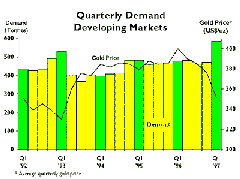
Which Way The Gold Price?Our OpinionIt may come as a surprise that we do not often venture a strong opinion as to the future direction of the gold price.We do not pretend to be experts at prediction of market prices, indeed we believe that there are very few people who could claim consistent success at predicting future gold price movements. We also prefer to point out obvious and potential fundamental factors, and allow our customers to form their own judgements. As at February 2000, we believe we can envisage one important factor which may have a significant effect on the gold price over the next few years.
First, The Past!In any attempt to foresee the future, it is necessary to look at history, to see what insights we may be able to glean from the past.We do not intend to give here a full analysis of past gold prices, but we will attempt to give a brief summary. From 1100 AD to 1931 AD, when Britain abandoned the gold standard, the price of gold remained steady at about £3.89, apart from a few brief "blips" in either direction. In 1935 the US Treasury fixed the price of gold at $35 per ounce, although the aim was to stabilise the dollar. Britain devalued the pound from $4.03 to £2.80 in 1949, or in terms of gold, from £8.68 to £12.50 per ounce. In December 1971 (we have seen a date quoted as August 15th), the dollar was devalued to $38 per ounce from $35, and again in February 1973 to an "official" price of $42.22, and even this was abandoned by November 1973. From then the dollar "floated" although "sank" may be a more accurate description, until gold reached $850, just under £400, per ounce in 1974. As with most huge price upheavals, this increase was overdone, and gold has since fluctuated down to about $270, back to $350, and is currently around the $300 per ounce level. Until the past few months, our view of gold trends is that the price would stay in the recent range for the next few years and more.
Central Bank SalesDuring the last decade, many central banks have been reducing the proportion of gold held as part of their currency reserves. We believe that this is probably a reasonable, sound move in keeping with modern theories of currency and foreign exchange management, after all most currencies are now token currencies, their value being related more to the general perception of their worth, dictated by trade imbalances and supply and demand. Whether it proves to be a completely sound principle will probably not be fully known for another fifty years or so.We are aware that the World Gold Council has consistently argued against Central bank sell-offs, but as it is financed by the gold producers, this is only to be expected. The effect of the Central bank sales has been to significantly increase the supply to the market, and it has understandably has the effect of reducing gold prices. Within the next few years, we believe that Central bank sales will slow down, perhaps stop, and it is entirely possible that they may eventually return as net gold buyers, particularly on any weakness in the gold price. Obviously the reduction or cessation of a flow of Central banks gold onto the market will exert an upward pressure on prices.
Producer HedgingAlthough prices recently rose on announcements that several gold producers were to stop or reduce their hedging activities, whereby they borrow gold, sell it, invest the proceeds, and repay the gold from future production, we believe that this probably reflects their longer term views of market fundamentals, rather than being in itself a prime influence on market prices. If the gold miners believe that it will in the near future be advantageous for them to stop short-selling, then presumably their analysts believe that firmer prices are likely.
An Upward TrendAs the world demand for gold has absorbed quite large quantities of Central banks gold stocks over the past decade, with only a fairly small downward effect on prices, we believe that gold prices are more likely to increase over the next few years than to decrease. Certainly the upside potential must now be considerably stronger than the downside potential.12th February 2000
November 2005 - $500 Awaited, $1,000 ForecastAt the end of November 2005, we were expecting gold to touch $500 for the first time since 1987.Pierre Lassonde, the President of Newmont Mining has recently forecast that gold will hit $1,000 in the next 5 to 7 years. We are used to hearing claims and forecasts (of up to £17,000 per ounce) from the lunatic fringe, but this forecast came from a highly respected source, and we have no doubt that it was well-reasoned.
2009 LBMA Gold Price Forecasts
2010 LBMA Gold Price Forecasts
Factors Affecting Gold PricesBrief notes about different factors which influence the gold bullion price.
|

The World Gold Council compile regular and abundant statistics on the gold market.
|